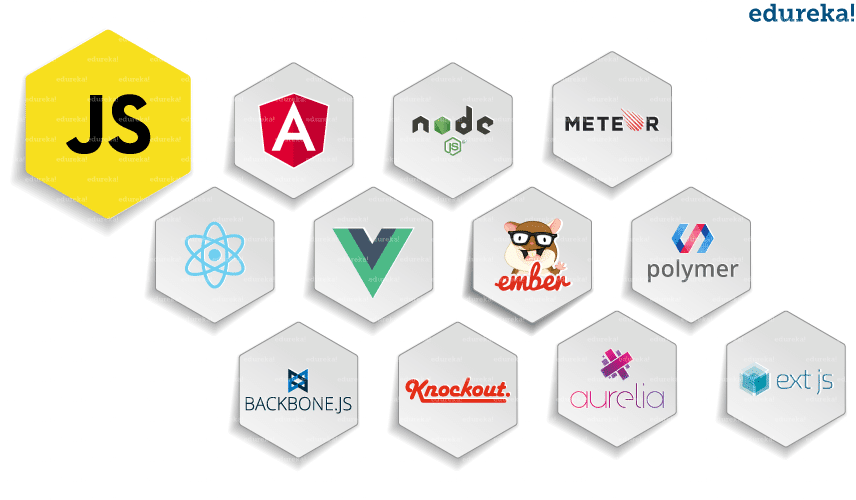What Is React?
Do you remember how Facebook’s UI or it’s messenger looked a few years back? During that time you had to refresh or reload the entire page for new updates or messages repeatedly. But now it’s no longer required. Today, each time there is a new update or message, a notification will pop up. Clicking on that will then automatically refresh your page and show you the latest updates. So, how exactly does this happen? Well, this is the magic of ReactJS and in this blog, I am going to discuss what is React and why you should go for it.
JavaScript Frameworks
Javascript is a dynamic programming language which is widely used for developing web applications. It is very lightweight and is supported by most of the modern browsers. Moreover, JavaScript supports both object-oriented programming and procedural programming. Thus, it is used for creating web pages with a client-side script to interact with the user and make the web pages dynamic and robust.
JavaScript has many frameworks among which we can choose depending on our need. Below diagram shows some popular JavaScript frameworks.
Following are the major advantages provided by the JavaScript Frameworks:
Efficiency: With the use of pre-built patterns and functions, the development of the applications became easy. The projects which used to take months to develop can now be developed in very less time. This increased the efficiency as well as reduced the time and effort involved.
Security: As JavaScript is an open source community, its top frameworks have strong security arrangements. Frameworks are supported by these large communities in which, the members and the users can also act as testers. This increases the chances of detecting any kind of backdoor or bug present in the framework. Thus providing better security at less cost.
Cost Reduction: JavaScript Frameworks are free for public use as they are open source. So, when we develop a web application using these frameworks, the overall cost of the application is much lesser.
Because of all these advantages, JavaScript frameworks are used heavily for developing web-applications. They have already proved their potential over the past few years. Among them, the most popular ones are React and Angular. “Even though React is young, it is giving a neck to neck competition to Angular”. If you are planning to make a flourishing career in web development, React Certification Training is the right move for you.
So, through this blog, we’ll be learning all about ReactJS. But before understanding what is React, you need to understand why we need it in the first place.
Why React?
There were so many JavaScript frameworks available in the market but still React came into the picture. Let’s dive little deeper and find out the reason why ReactJS was needed.
The previous frameworks were using a traditional data flow as you can see from the below diagram.
Here, the data is received from various sources like initial data, real-time data and user input data which is passed to the dispatcher. The dispatcher then forwards this data to the store, from where it ultimately comes to the view. Now, the view is the part where you or a user interact with the application. So, whatever you see on the browser as a web page is the view itself.
But, what do you think happens at the back end of the frameworks using this traditional data flow?
Each time new data is added or any data is updated at the back end, the browser reloads the web page and repeats the whole process again. Only after this, we can see the updated data on the view. But this traditional data flow has one major drawback, it uses the DOM (Document Object Model). DOM is an object that is created by the browser each time a web page is loaded which can dynamically add or remove the data at the back end. But each time any modifications were done a new DOM is created for the same page. This repeated creation of DOM results in unnecessary memory wastage and a decrease in applications performance.
Moreover, manipulating DOM was very expensive. Therefore, there was a search for new technology which could save us from this trouble. This is where ReactJS comes to our rescue. With ReactJS, you can divide your entire application into various independent components. ReactJS applications still used the same traditional data flow, but something changed at the back end. Below diagram shows exactly what was going on at the back end.
Now, each time any data is added or updated from the back end, ReactJS uses a new tactic to deal with it. Instead of reloading the entire page, what React does is, it just destroys the old view. Afterward, it renders the view components with updates or new data and then places the new view in place of the old one. As a solution to the memory wastage due to DOM, React introduced Virtual DOM. You might be curious about what is this virtual DOM and how it solves our problem? Don’t worry, I’ll be explaining that later in this blog in detail, but for now, let’s understand what is React.
What Is React?
React is a component-based library which is used to develop interactive UI’s (User Interfaces). It is currently one of the most popular JavaScript front-end libraries which has a strong foundation and a large community supporting it.
NOTE: ReactJS is only a frontend library and not the whole framework, which deals with the View component of MVC (Model – View – Controller).
In ReactJS, everything is a component. Consider one lego house as an entire application. Then compare each of the lego blocks to a component which acts as a building block. These blocks/ components are integrated together to build one bigger and dynamic application.
The biggest advantage of using components is that you can change any component at any point in time without affecting the rest of the applications. This feature is most effective when implemented with larger and real-time applications where data changes frequently. Each time any data is added or updated, ReactJS automatically updates the specific component whose state has actually changed. This saves the browser from the task of reloading the whole application to reflect the changes.
ReactJS was developed by Jordan Walke, a software engineer working at Facebook. Facebook implemented ReactJS in 2011 in its newsfeed section, but it was released to the public in May 2013. After the implementation of ReactJS, Facebook’s UI underwent drastic improvement. This resulted in satisfied users and a sudden boost in its popularity.
Features Of React
Now that you have understood what is React and why it is used, lets now uncover few of its intriguing features.
JSX: JSX stands for JavaScript XML. Its an XML/ HTML like syntax used by React. It extends the ECMAScript so that XML/ HTML like text can co-exist along with JavaScript react code. This syntax is used by the pre-processors like Babel to transform HTML like text found in JavaScript files into standard JavaScript objects. With JSX, we can go a step further by again embedding the HTML code inside the JavaScript. This makes HTML codes easy to understand and boosts JavaScript’s performance while making our application robust.
Virtual DOM: Like an actual DOM, virtual DOM is also a node tree that lists the elements and their attributes and content as Objects and their properties. React’s render function creates a node tree out of the React components. Then, it updates this tree in response to the mutations in data model caused by various actions done either by the user or by the system.
This virtual DOM works in three simple steps.
- Whenever any underlying data changes, the entire UI is re-rendered in Virtual DOM representation.
- Then the difference between the previous DOM representation and the new one is calculated.
- Once the calculations are done, the real DOM will be updated with only the things that have actually changed. You can think of it as a patch. As patches are applied only to the affected area, similarly, the virtual DOM acts as patches and are applied to the elements which are updated or changed, in the real DOM.
Testability: React views can be used as functions of the state (state is an object which determines how a component will render and behave). Thus, we can easily manipulate with state of the components which we pass to the ReactJS view and take a look at the output and triggered actions, events, functions, etc. This makes React applications quite easy to test and debug.
Server-Side Rendering(SSR): Server-Side rendering allows you to pre-render the initial state of your react components at the server side only. With SSR, the server’s response to the browser becomes only the HTML of the page which is now ready to be rendered. Thus, the browser can now start rendering without having to wait for all the JavaScript to be loaded and executed. As a result, the webpage loads faster. Here the user will be able to see the web page in spite of React still downloading the JavaScript, creating the virtual DOM, linking events, etc. at the back end.
One-Way Data Binding: Unlike other frameworks, ReactJS follows unidirectional data flow or one-way data binding. The major advantage of One-Way-Data binding is that throughout the application the data flows in a single direction which gives you better control over it. Because of this, application’s state is contained in specific stores and as a result, rest of the components remains loosely coupled. This makes our application more flexible leading to increased efficiency.
Simplicity: Use of JSX files makes the application really simple and
easylearning curve - What Is React - Edureka to code as well as understand. Even though we can use plain JavaScript here, using JSX is easier. React’s component-based approach along with distinct lifecycle methods also make it simple to learn.









Top comments (0)